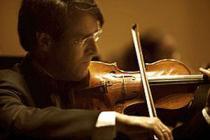The thing to convey for me with Lark Ascending, even if you've never heard of it, don't know Vaughan Williams, or don't really go to classical music concerts, is that this is one of those things that, yes, everybody will pretty much agree, "that's beautiful." And its being beautiful is in fact what it's all about. It's like inviting people to come watch a stunning sunset. It's about sonorities, the beauty of what you're hearing, the beauty of what it's symbolizing, and the beauty of where it puts you mentally and emotionally when you're listening to it. It's this wonderful, meditative, relaxed, smile-on-your-face kind of thing.

Vaughan Williams wrote the work in 1914, inspired by George Meredith's poem of the same name in honor of the skylark, a European bird that soars some 300 feet above the ground calling out for a mate:
For singing till his heaven fills, 'Tis love of earth that he instils, And ever winging up and up, Our valley is his golden cup, And he the wine which overflows To lift us with him as he goes
Whitman Choral Masterpiece
The second work of Vaughan Williams on the program has its soaring moments too, but the range of emotion is vast, being a choral setting of several poems of Walt Whitman (among other texts) on the imperatives, heartbreak, and need for perspective in facing the horrors of war.Stephen McKersie, director of the Marin Symphony Chorus and Chamber Chorus, describes his three favorite sections of the work, which is titled Dona Nobis Pacem (Give us peace):

The second work of Vaughan Williams on the program has its soaring moments too, but the range of emotion is vast, being a choral setting of several poems of Walt Whitman (among other texts) on the imperatives, heartbreak, and need for perspective in facing the horrors of war. Stephen McKersie, director of the Marin Symphony Chorus and Chamber Chorus, describes his three favorite sections of the work, which is titled Dona Nobis Pacem (Give us peace):
I think one of the most spectacular movements is the second, "Beat, beat drums," which really goes into the carnage and horrors of war. "Reconciliation," too, which is the third movement, contains one of my favorite lines in the whole piece [see illustration below]. And the way it is interpreted musically is so absolutely gorgeous — it's a three-minute section that just floats. The other section I really like is the "Dirge for two veterans," which Vaughan Williams wrote 26 years before he finished the piece, when he was a younger composer. And the last movement, this really huge choral fantasy that ends up with total exhilaration.

Whitman and Vaughan Williams both saw the carnage of war up front and personal: Each tended the wounded — Whitman as a hospital orderly in the Civil War, Vaughan Williams as an ambulance driver in World War I.
Vaughan Williams wrote Dona Nobis Pacem in 1936, as storm clouds were threatening Europe with further calamity, in view of the rise of Fascism. Tragically, the warmongers were immune to artistic pleas from any quarter. Finishing up the Marin Symphony evening, after intermission, will be a welcome contrast to the intense first half: Bizet's Symphony in C, written as a student exercise when the composer was only 17, but lying buried and unplayed in the Paris Conservatory archives until it was rediscovered in 1935. Music Director Alasdair Neale summarizes the components of the contrasting halves of the program with an apt metaphor:
All three are wonderful pieces; they just show different sides of the face of classical music. The first half is a mixture of inspired contemplation and then a really deeply felt work, the Dona Nobis Pacem. The second half is just like a champagne cork popping for 30 minutes.

